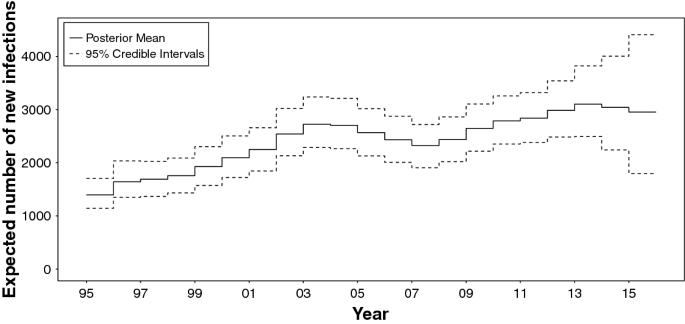
Our improved methodology deals effectively with the change in AIDS case definition and has allowed quantitative assessments of the HIV epidemic by birth cohort using all AIDS cases diagnosed before 1996, thus providing a sound basis for public health policy at a time when estimation of more recent prevalence is compromised by the effects of HAART. 311 More recently, the precision in estimates of recent incidence has been improved by the incorporation into modeling of information from HIV/non-AIDS cases. AbstractCD4-based multi-state back-calculation methods are key for monitoring the HIV epidemic, providing estimates of HIV incidence and diagnosis rates by disentangling their inter-related contribution to the observed surveillance data. Estimated New HIV Infections, Extended Back Calculation Model, 50 US States and DC. against the virus based on specific HIV antibody concentration, proportion, isotype or avidity. The percentage of people infected with HIV in a population. to estimate HIV incidence by age in the general population using successive rounds of cross. (B) Backcalculated number of infections per month by single year of age. During the last decade, this method has also been extended to prion diseases such as Bovine Spongiform Encephalopathy (BSE) 16,17, vCJD 18-22 and Kuru 23.


Towards elimination of HIV transmission, AIDS and HIV-related deaths. 2 (A) Monthly AIDS incidence counts among white males for January 1982 through. diseases the backcalculation method uses the incubation period to estimate HIV prevalence and project the future incidence of AIDS 14,15. In the European Union, incidence is estimated to have peaked in 1983 among homosexual men and in 1988 among injecting drug users 460000 persons were estimated to be living with HIV/AIDS at the end of 1995. Advancing substantially over the past 2 decades, backcalculation techniques have addressed many challenges of estimating population-based HIV incidence and prevalence. models, demographic models, back-calculation techniques and birth cohort methods. the first year of diagnosis (26.1 per 1,000 population aged 15 to 59 years). Otherwise, birth cohort analysis, with moderate effects of age on progression, gave initially increasing incidence curves and consistent patterns across countries, with the 1960-1964 cohort most affected. EBBC by 5-year birth cohort assumed a minimum age at infection and age-dependent progression rates three versions, with varying age effects, were investigated using AIDS cases diagnosed prior to the introduction of highly active antiretroviral therapies (HAART).Ĭompared with the no age-effect version, EBBC by birth cohort tended to produce flattened HIV incidence curves in country-exposure groups with < 1000 AIDS cases, reflecting effects of the neighbour prior when data become sparse.

To adapt and improve methodology for back-calculation of AIDS in Europe and to examine the feasibility of estimating past HIV incidence by birth cohort.Įmpirical Bayesian back-calculation (EBBC) used Markov disease progression models, modified to allow for three diseases added to the AIDS case definition in 1993 and for pre-AIDS mortality, and estimation by penalized maximum likelihood with a neighbour prior. This paper extends the use of backcalculation to estimate past incidence of HIV infection in different age groups from agespecific counts of AIDS incidence.


 0 kommentar(er)
0 kommentar(er)
